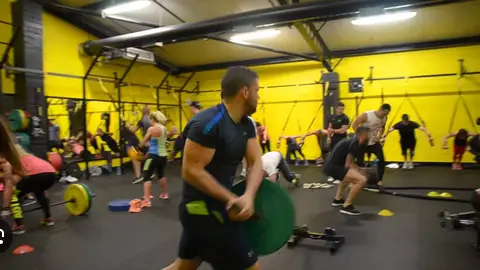Kickstart fitness journey with a full-body workout. Discover how this beginner-friendly approach engages multiple muscle groups, delivering lasting results and success.
Efficiency and Time-Saving
For beginners, time is often a significant consideration when starting a fitness routine. Many may have busy schedules, leaving little room for long, intricate workout sessions. Full-body workouts are the perfect solution, offering a complete training session in a shorter amount of time. Rather than isolating specific muscle groups on different days, full-body routines target all major muscle groups in a single session, making it possible to achieve balanced muscle development within a compact timeframe. This efficiency allows beginners to commit to a consistent workout regimen without feeling overwhelmed or discouraged by long hours at the gym.

Improved Muscle Coordination
A hallmark of full-body training is its ability to promote improved muscle coordination. By engaging multiple muscle groups at once, full-body workouts enhance the way muscles work together to complete a task. Beginners who adopt this approach often find that they develop a better understanding of how their body moves as a unit. Compound movements such as squats, lunges, and push-ups require the coordination of various muscles in synergy, fostering functional strength. This heightened awareness of body mechanics not only makes exercises more effective but also translates to real-world benefits, such as improved posture and movement efficiency in daily activities.
Balanced Muscle Development
One common mistake many beginners make is focusing too heavily on specific muscle groups, such as the arms or abs while neglecting others. This imbalance can lead to poor posture, muscle imbalances, and even injury over time. Full body workouts prevent this by ensuring that all major muscle groups are targeted evenly. This balanced approach results in proportionate muscle development, creating a symmetrical physique. Additionally, strengthening all muscle groups together helps prevent overuse injuries that often arise from focusing on one area while neglecting others. By targeting both upper and lower body muscles, beginners can develop a strong, well-rounded foundation from the very start.
Increased Fat Burn and Calorie Burn
For those aiming to lose weight or shed excess fat, the full-body workout method is an excellent choice. Engaging multiple muscle groups during each session leads to an increased calorie burn both during and after the workout. Compound exercises, such as deadlifts and burpees, require more energy to perform, which boosts the body’s metabolism. The result is an elevated afterburn effect, known as excess post-exercise oxygen consumption (EPOC). This means that even after the workout is complete, the body continues to burn calories at an accelerated rate. For beginners, this added metabolic boost helps expedite fat loss, contributing to faster and more noticeable results.

Faster Progression and Adaptation
One of the primary goals for beginners is to see tangible improvements in strength and fitness. Full body workouts facilitate faster progression by allowing individuals to target different muscle groups frequently, providing enough variation to promote continuous improvement. In contrast to split training routines, which often work muscles only once or twice a week, full-body training provides more frequent stimulus to the muscles, leading to faster adaptation. This frequent activation enhances muscle strength, endurance, and overall fitness much more rapidly, giving beginners the satisfaction of witnessing noticeable results in a shorter period.
Greater Cardiovascular Benefits
Full-body workouts are not just about strength; they also provide significant cardiovascular benefits. Many full-body exercises, such as jumping jacks, mountain climbers, and high-intensity interval training (HIIT) movements, elevate the heart rate, effectively working the heart and lungs in addition to the muscles. This dual focus on strength and cardiovascular conditioning makes full-body training an ideal choice for beginners who are looking to improve their overall fitness. A heart-healthy cardiovascular system supports long-term health and enhances endurance, allowing beginners to become more efficient in their workouts and daily activities.
Simplicity and Flexibility
For beginners, simplicity is key. The full-body workout method is straightforward, offering a variety of exercises that are easy to learn and can be tailored to suit individual goals and fitness levels. Whether a beginner is training at home with minimal equipment or at the gym with access to machines and free weights, full-body exercises can be adjusted to match their current abilities. This flexibility ensures that full-body routines are not only manageable but also adaptable as the individual progresses in their fitness journey. Beginners can start with bodyweight exercises and gradually incorporate weights and resistance as they build strength and confidence.
Mental Toughness and Consistency
The full-body workout approach is demanding, which fosters the development of mental toughness. Completing a full-body workout requires both physical endurance and the ability to push through fatigue. For beginners, these challenges are an opportunity to develop resilience and perseverance, which can positively impact other areas of life. As individuals continue to work through the intensity of full body sessions, they cultivate consistency and determination, two crucial traits for long-term fitness success. Overcoming challenges in the gym helps instill a sense of achievement, motivating individuals to stay committed to their goals and see their efforts pay off.
Enhancing Flexibility and Mobility
Unlike more rigid workout routines, full-body exercises incorporate a variety of movements that improve flexibility and mobility. Squats, lunges, and twisting exercises not only strengthen muscles but also enhance the range of motion in the joints. For beginners, this increased mobility can be a game-changer, reducing stiffness and improving movement efficiency in daily life. Flexibility is often overlooked in traditional strength training but is an essential component of a well-rounded fitness program. Full-body workouts promote greater joint health and functional movement, which can lead to a decrease in injury risk and an overall increase in mobility.
Sustainability and Long-Term Success
A major benefit of the full-body approach for beginners is its ability to promote sustainability. Unlike specialized workout plans that may lead to burnout due to excessive focus on one muscle group, full-body workouts are less monotonous and more enjoyable. The variation in exercises and muscle groups targeted keeps things fresh, preventing the routine from feeling stale. Furthermore, full-body workouts are effective for beginners at any fitness level, providing enough variety to sustain interest and progress for the long haul. This long-term sustainability helps individuals maintain their fitness habits and continue seeing results over time.
Conclusion
For beginners, the full-body approach is an ideal method for jumpstarting a fitness journey. It offers numerous benefits, including increased efficiency, balanced muscle development, and enhanced cardiovascular health. By engaging multiple muscle groups, full-body workouts help burn fat, build strength, and improve coordination, all while preventing the common pitfalls of muscle imbalances and overtraining. With a focus on sustainability and long-term results, this method not only lays the foundation for immediate fitness success but also encourages the development of habits that can last a lifetime.
FAQ
What is a beginner 30-day full-body challenge?
A beginner 30-day full-body challenge is a workout plan designed to engage all major muscle groups throughout the body, promoting strength, endurance, and overall fitness. It typically includes exercises that target both the upper and lower body, ensuring balanced development.
How can a 30-day full-body challenge help kickstart my fitness journey?
A 30-day full-body challenge helps build a strong foundation for fitness by improving muscle coordination, boosting metabolism, and enhancing overall strength and endurance. It’s a structured, consistent approach to ensure steady progress and motivation, making it an ideal starting point for beginners.
What exercises are included in a 30-day full-body challenge for beginners?
Common exercises include squats, lunges, push-ups, planks, burpees, and bodyweight rows. These exercises are designed to engage multiple muscle groups, improving strength, flexibility, and cardiovascular health. Some routines may also incorporate light weights or resistance bands.
How much time should I spend on each workout during the 30-day challenge?
Beginners should aim for about 20-30 minutes per workout, with a focus on form and technique. As you progress, the intensity and duration can be gradually increased to challenge your body further. The key is consistency and listening to your body.
What are the benefits of doing a full-body workout every day?
Full body workouts provide comprehensive muscle engagement, improve coordination, promote balanced muscle development, and increase calorie burn. Doing them daily helps build strength, endurance, and metabolic efficiency, aiding faster progress toward fitness goals.
How should I prepare for a 30-day full-body challenge as a beginner?
Preparing for a 30-day full-body challenge involves setting clear fitness goals, ensuring proper nutrition, staying hydrated, and getting the right gear. It’s also important to start with an assessment of your current fitness level to tailor the challenge to your needs.
Can I modify the 30-day full-body challenge if I have limited equipment?
Yes, the 30-day full-body challenge can be easily modified for limited equipment. Bodyweight exercises like squats, push-ups, and lunges are highly effective, and resistance bands or household items like water bottles can be used to increase intensity.
How do I track my progress during the 30-day full-body challenge?
Tracking progress can be done by recording the number of reps and sets completed for each exercise, noting physical changes (such as weight loss or muscle definition), and tracking overall energy levels and performance improvements over time. Regular assessments will help keep you motivated.
What kind of results can I expect from completing a 30-day full-body challenge?
Results vary by individual, but typically, you can expect increased muscle tone, improved endurance, better posture, weight loss, and enhanced overall fitness. Consistency is key, and many beginners report feeling stronger and more energized by the end of the challenge.

Your writing is a true testament to your expertise and dedication to your craft. I’m continually impressed by the depth of your knowledge and the clarity of your explanations. Keep up the phenomenal work!